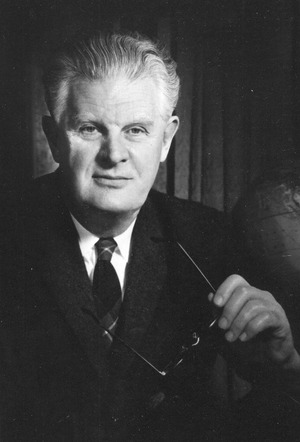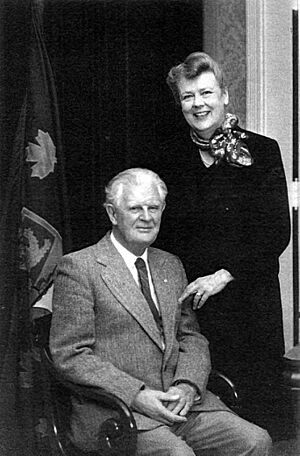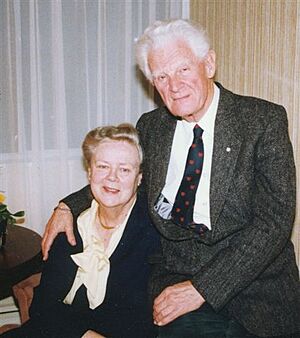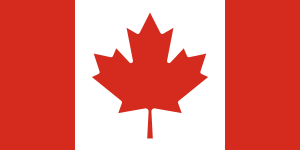George Stanley facts for kids
Quick facts for kids
Lieutenant-Colonel the Honourable
George F. G. Stanley
CC CD FRSC FRHSC(hon)
|
|
|---|---|

George Stanley in the 1960s.
|
|
| Birth name | George Francis Gillman Stanley |
| Born | July 6, 1907 Calgary, Alberta, Canada |
| Died | September 13, 2002 (aged 95) Sackville, New Brunswick, Canada |
| Buried |
Sackville Cemetery
|
| Allegiance | Canada |
| Awards | CC, CD, KStJ, DPhil, DLitt, FRSC, FRHistS, FRHSC (hon.) |
| Alma mater | University of Oxford |
| Spouse(s) | Ruth Stanley |
| Other work | historian, author, soldier, teacher, public servant |
| 25th Lieutenant-Governor of New Brunswick | |
| In office December 23, 1981 – August 14, 1987 |
|
| Monarch | Elizabeth II |
| Governor General | Edward Schreyer Jeanne Sauvé |
| Premier | Richard Hatfield |
| Preceded by | Hédard Robichaud |
| Succeeded by | Gilbert Finn |
| Military service | |
| Allegiance | Canada |
Colonel George Francis Gillman Stanley (July 6, 1907 – September 13, 2002) was a famous Canadian author, soldier, and historian. He taught at Mount Allison University and was a public servant. He is best known for designing the Canadian Flag.
Contents
Early Life and Education
George F. G. Stanley was born in Calgary, Alberta in 1907. He earned a Bachelor of Arts degree from the University of Alberta in Edmonton. In 1929, he became a Rhodes Scholar and studied at Keble College, University of Oxford.
While at Oxford, he earned several advanced degrees, including a Doctor of Philosophy (DPhil). He was also a talented athlete, playing for the Oxford University Ice Hockey Club. His team even won the Spengler Cup in 1931. During his time at Oxford, he started writing his book, The Birth of Western Canada: A History of The Riel Rebellions. This began his lifelong interest in the history of Louis Riel.
A Career in Academia and the Military
Becoming a Professor and Soldier
In 1936, Stanley returned to Canada and became a history professor at Mount Allison University in New Brunswick. He also joined the military as a lieutenant in the New Brunswick Rangers.
During World War II, he served overseas in London, England. He worked as a historian for the Canadian Army. He also managed the War Artist Program, which included famous artists like Alex Colville. Stanley left the military in 1947 as a Lieutenant-Colonel.
After the war, he taught at the University of British Columbia. He held the first-ever chair in Canadian history in Canada.
Teaching at Royal Military College
In 1949, Stanley began teaching at the Royal Military College of Canada (RMC) in Kingston, Ontario. He stayed there for 20 years. He became the head of the History Department and the first Dean of Arts. He helped build the arts and social sciences programs at RMC.
He taught the first undergraduate course in military history in Canada. His textbook, Canada's Soldiers, 1604-1954, was required reading for military personnel for 30 years. Many of his students became important historians and leaders.
While in Kingston, he was very active in the community. He worked to preserve old buildings and was involved in many historical societies. He also served as president of the Canadian Historical Association.
Return to Mount Allison and Retirement
In 1969, Stanley went back to Mount Allison University. He became the first director of the new Canadian Studies program. This was the first program of its kind in Canada. He taught courses on Canadian culture, including literature, music, and architecture.
George Stanley retired from teaching in 1975. However, he remained active in public life. From 1981 to 1987, he served as the Lieutenant-Governor of New Brunswick. This is a special role representing the Queen in the province.
During his time as Lieutenant-Governor, he continued to work on The Collected Writings of Louis Riel. This five-volume project was published in 1985. Even in his nineties, Stanley continued to research, write, and encourage young scholars. He often answered letters from schoolchildren asking about the Canadian flag. He passed away in 2002 and was buried with full military honors.
His Lasting Impact
Many people were influenced by George Stanley. His students remember him as a great role model and a kind person. He encouraged them to think for themselves.
Desmond Morton, a famous Canadian military historian, was one of Stanley's students. He said that Stanley's books were a great contribution to Canada. Stanley often argued for the rights of French Canada, which was not always popular at the time.
Historian R.C. Macleod noted that Stanley's book, The Birth of Western Canada, is still widely read today. It helped many English Canadians understand the history of the Canadian West.
Public Service and Family Life
In 1981, Prime Minister Pierre Trudeau appointed George Stanley as the 25th Lieutenant-Governor of New Brunswick. This was a very busy time for New Brunswick. The province celebrated its 200th anniversary. Important visitors like Queen Elizabeth II and Pope John Paul II also came to celebrate. George and Ruth Stanley were known for their strong sense of tradition and their friendly way with people.
In 1946, George Stanley married Ruth L. Hill (1922–2017). Ruth was a lawyer from Montreal. They had three daughters: Della, Marietta, and Laurie. They also had two grandchildren.
Honours and Recognition
George Stanley received many honours for his work. In 1976, he was made an Officer of the Order of Canada, and later a Companion in 1994. The Order of Canada is one of the highest honours a Canadian can receive.
He also received 12 honorary degrees from different universities. He was a Fellow of the Royal Society of Canada and the Royal Historical Society. In 1950, he won the Royal Society of Canada's J. B. Tyrrell Historical Medal.
In 1955, he became president of the Canadian Historical Association. His important speech, "Act or Pact? Another Look at Confederation," is still studied by students of Canadian history. He was also an Honorary Ex-Cadet of the Royal Military College.
Many places and things have been named in his honour. These include historical plaques, a street in Sackville, NB, and the Dr. George Stanley School in Calgary. In 2018, a life-size bronze statue of Stanley was put up in Sackville, New Brunswick.
Designing the Canadian Flag
On March 23, 1964, George Stanley wrote an important memo to John Matheson. Matheson was a member of the special committee choosing a new Canadian flag. Stanley suggested that the new flag should be easy to recognize. It should use traditional colours and have a simple design. He even included a rough drawing of his idea.
Stanley and Matheson were friends. They had discussed the idea of a new flag over lunch at the Royal Military College. Stanley pointed to the college flag, which had a red-white-red design. He suggested this as a good base for the Canadian flag. In the middle, he proposed a single red maple leaf instead of the college's emblem.
Stanley's detailed memo explained the history of Canada's symbols. He warned against using symbols that might divide Canadians, like the Union Jack or a fleur-de-lis. His idea brought together all the key parts of the new flag design.
Stanley's design was placed among hundreds of others in the Flag Committee's meeting room in Ottawa. It was chosen as one of the final three designs. In the end, Stanley's design won. It beat out other ideas, including one from Prime Minister Lester B. Pearson.
A graphic artist named Jacques Saint-Cyr made a small change to Stanley's design. He reduced the number of points on the maple leaf from 13 to 11. Stanley's design was officially adopted as the national flag of Canada on December 15, 1964. It replaced the Canadian Red Ensign. The new flag took effect on February 15, 1965. This day is now known as National Flag of Canada Day.
At first, not all Canadians liked the new flag. Stanley even received a death threat before the official flag-raising ceremony. But he still attended the event, wearing a colourful Hudson's Bay coat.
Over time, support for the new flag grew quickly. In 1995, Prime Minister Jean Chrétien officially recognized George Stanley as the designer of Canada's flag. Stanley also suggested the name for the Canadian pale. This is a unique design feature first used in the Maple Leaf flag.
Today, the Stanley flag is a symbol recognized around the world. Former Governor-General David Johnston wrote that the flag encourages Canadians to continue building a free, fair, and inclusive country.
Selected Works of G.F.G. Stanley
- The Birth of Western Canada: A History of The Riel Rebellions (1936)
- Canada's Soldiers, 1604-1954: The Military History of An Unmilitary People (1954)
- Louis Riel (1963)
- The Story of Canada's Flag: A Historical Sketch (1965)
- New France: The Last Phase, 1744-1760 (1968)
- The War of 1812: Land Operations (1983)
- The Collected Writings of Louis Riel/Les Ecrits Complets de Louis Riel (1985)




